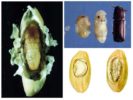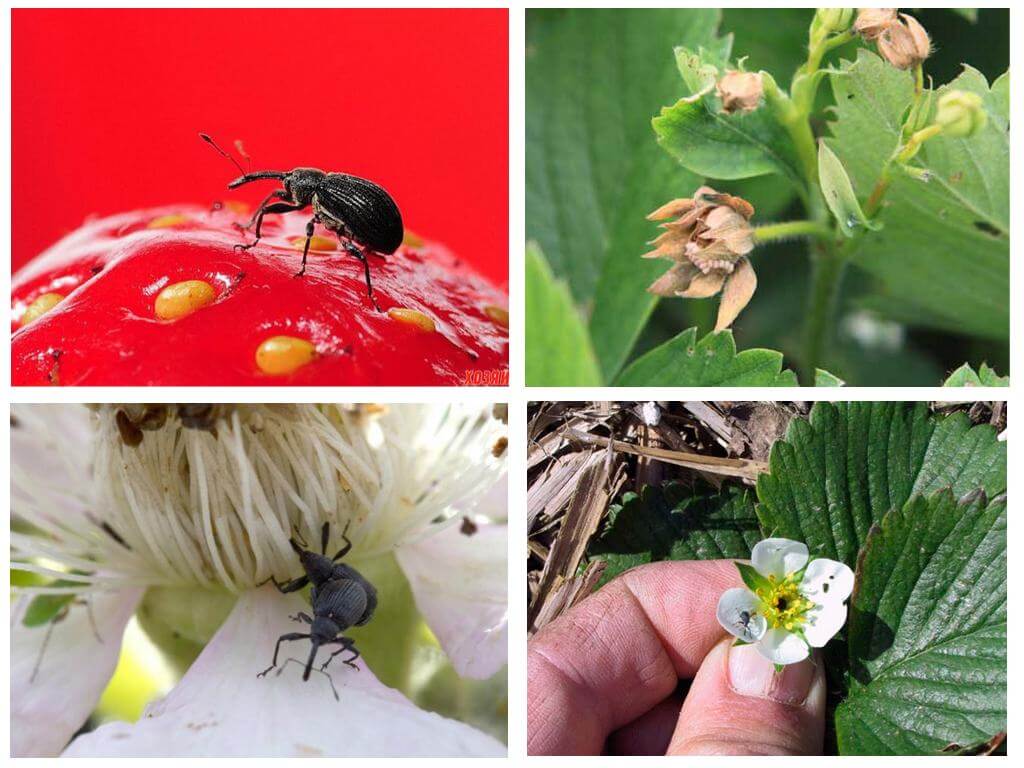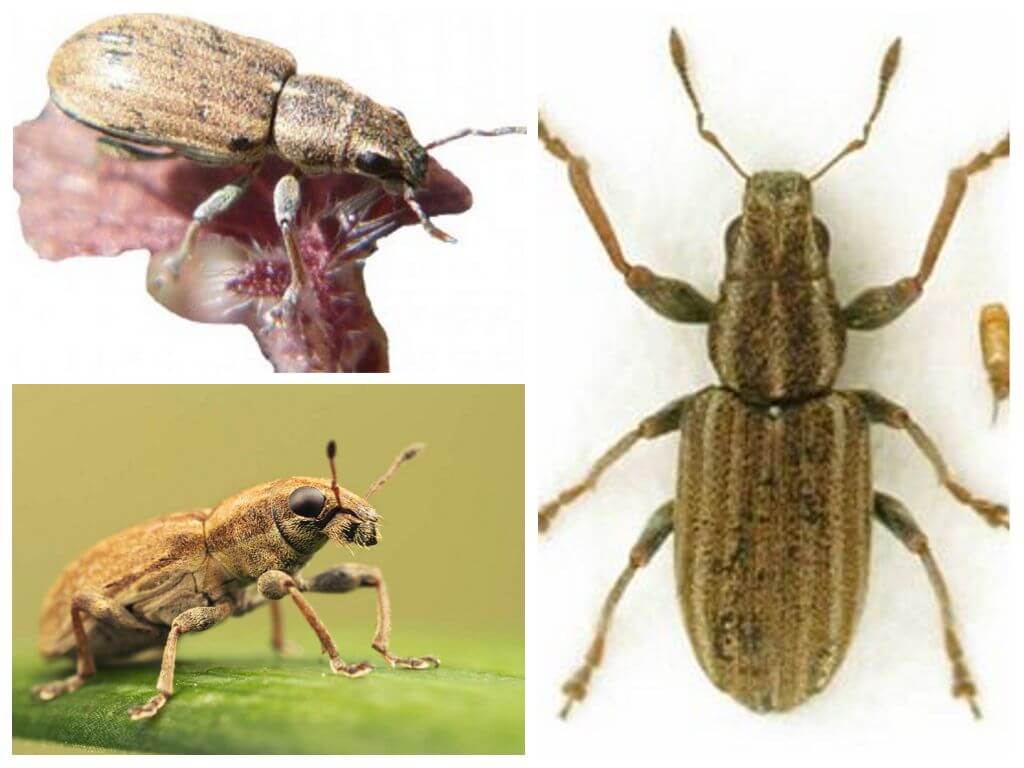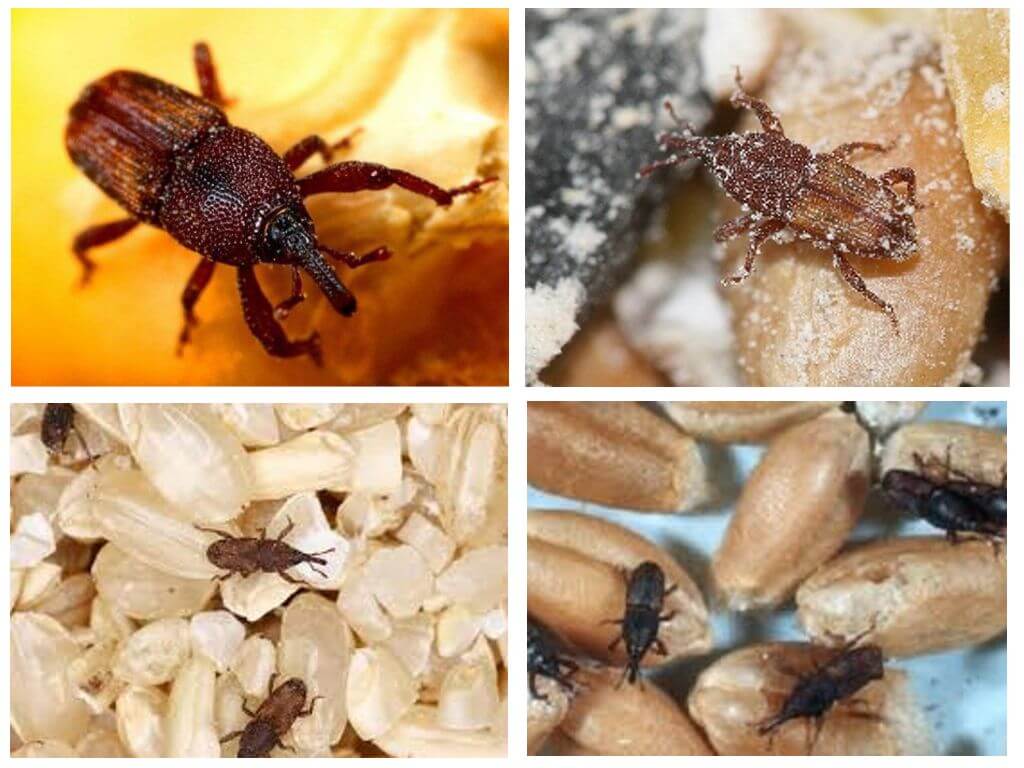- Barn Weevil
- Barn Weevil Larvae
- Barn weevil in the house
To immediately recognize the parasite in the product, you should study its description and characteristics. And in order to understand how to deal with it more efficiently, it is necessary to find out breeding methods, preferred conditions and other information.
Characteristic
Barn weevil is also called cereal. This is an insect whose body does not exceed 5 mm. The size of the bug depends on the food that he consumed during development. The body shape resembles a slightly narrowed cylinder, the surface is shiny. The color of the broad-mouthed depends on its age. So, young individuals are painted in a light brown color, while adults are almost black.
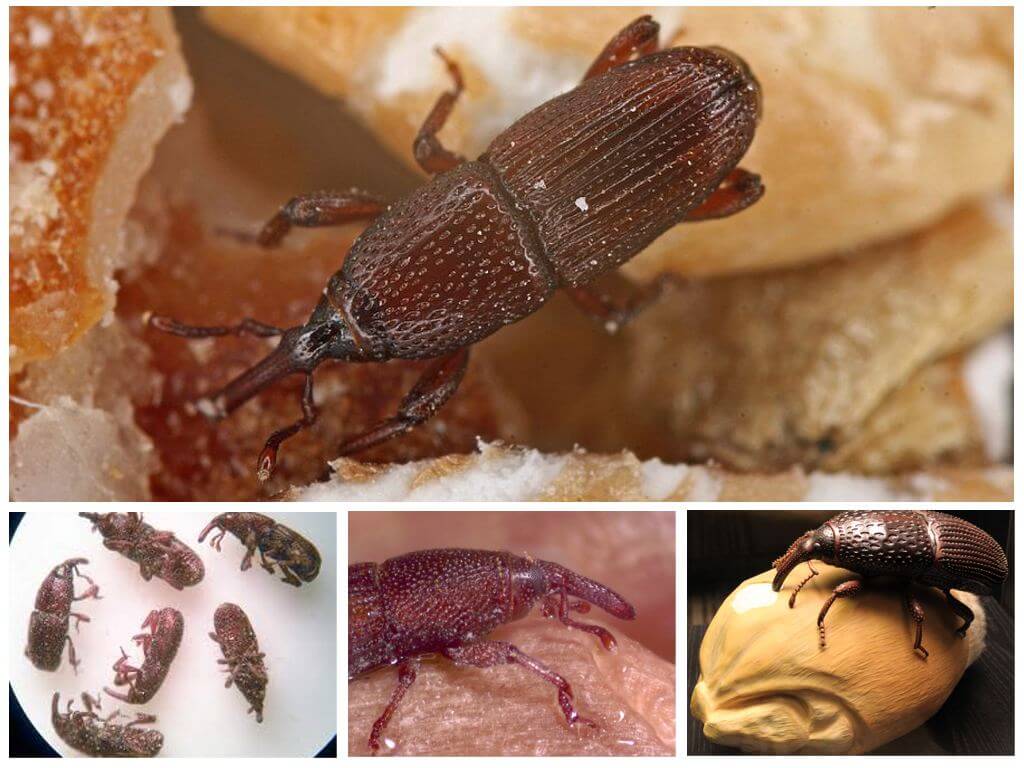
Head weevil very small, stretched forward into the cephalothorax, at the end of which is located the oral apparatus, with which the grain weevil gnaws at its food. The antennae located on the head are curved. The insect has wings: elytra with deep longitudinal grooves, membranous wings.
Interesting!
Despite the fact that the barn weevil is “equipped” with wings, it moves only with the help of the legs, since the development of the wings does not allow them to be used for these purposes.
Life cycle
Barn weevil absorbs a lot of feed, he is ready to use a variety of products: rice, beans, wheat, peas, oats, buckwheat and much more.
The biggest harm is done by the barn beetle larva. This light worm does not exceed 4 mm in dyne. In front, he has legs and a head with mandibles.
The female makes a masonry inside the grain, covering the outlet. The masonry is quite large: laying eggs, one female can spoil about 300 grains. Eggs develop for about 2 weeks, after which larvae appear. Young growth continues to develop all in the same seed, completely gnawing it from the inside. The transformation into a chrysalis occurs here. A barn weevil leaves the grain only after it becomes a mature adult.
Due to the fact that the development of the beetle occurs inside the grain, it can be very difficult to deal with it.
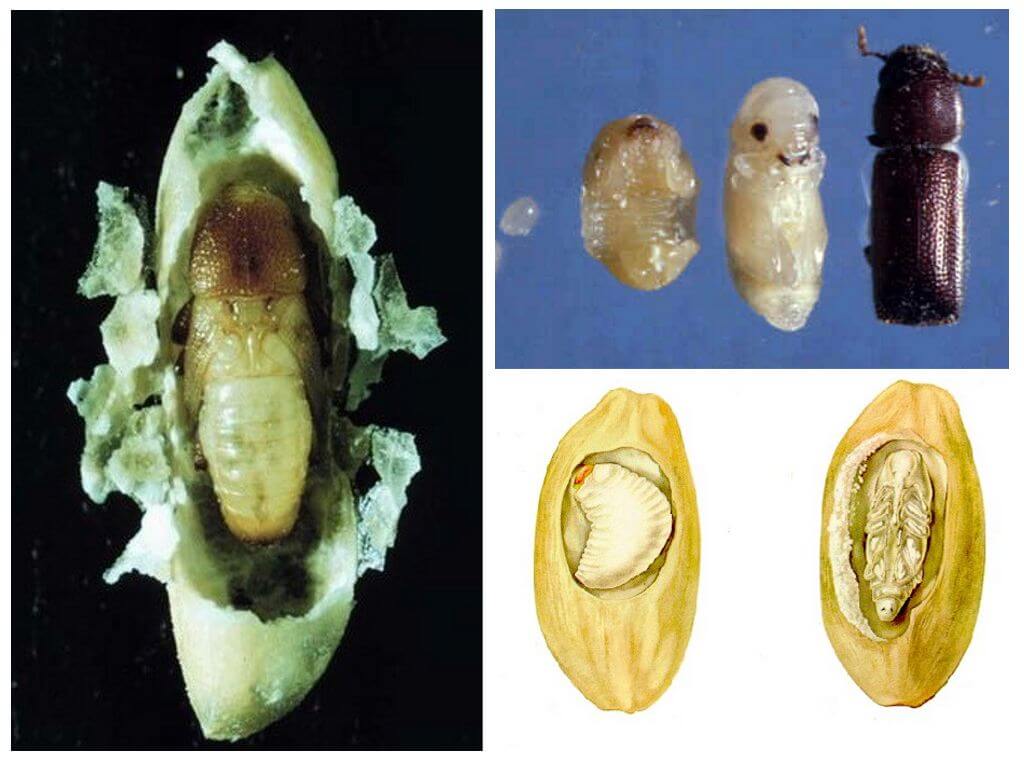
Interesting!
The rate of development depends on the ambient temperature:
- At 17 degrees, the beetle will come out of the grain in 80 days;
- At 20 degrees - through 70;
- At 25 - after 34 days;
- At 28 - after 30 days.
Features of Barn Weevil
Barn weevil prefers certain conditions for a comfortable life: air humidity should be 75-95%, cereal humidity up to 15%. Air temperature from 10 to 30 degrees.
Among insect pests, a barn or grain weevil is a long-liver: under favorable conditions, it can live and harm for more than a year. If the air temperature drops below 10 degrees, but does not reach +5, the bug will stop eating. At a temperature of about +3 degrees, the colony will fall into a stupor from the cold.And only if the temperature still drops, adult bugs will die.
The barn weevil is highly adaptable to environmental changes. It is able to tolerate not only serious changes in air temperature, but also its humidity, because almost the entire life of an insect passes inside the grain. Too much air will kill the bug.
Beetles can clutch 2-3 times a year. In addition to grains, bugs can wait out adversity in cracks, crevices and other corners.
Between the granaries and our housing, this barn bug moves inside the product, on inventory, or even on staff clothing.
Methods for dealing with barn weevil
You need to get rid of weevil in grain in the kitchen immediately, as it can infect other foods. If a package with grain is found in which the barn weevil lives, such a product must be discarded. Immediately after this, in order to avoid infection of other products, it is necessary to put into practice the knowledge of how to deal with a bug at home.
Home product protection
The "room" barn weevil in the photo looks quite peaceful, but in fact it is able to spoil all the products in the house. Most of all, he loves rice, but it will also attract wheat flavor. To get rid of an insectThere are several methods based on the characteristics and preferences of the beetle.
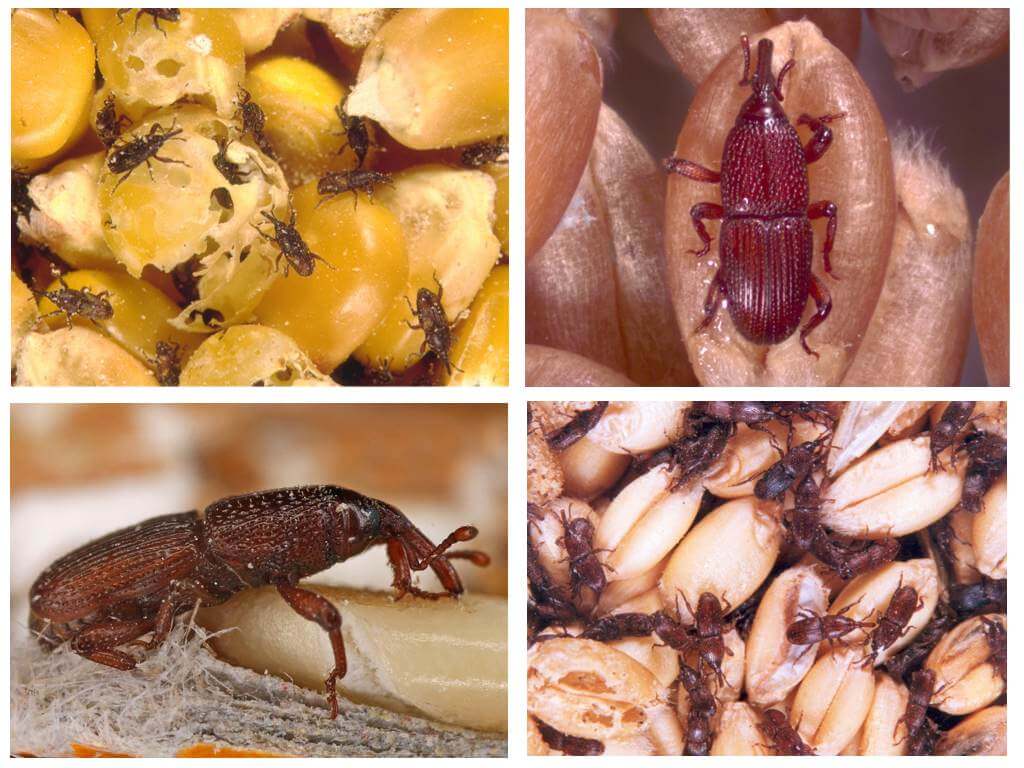
Before you deal with the barn weevil in the grain, you need to sort out all the loose ones in the cabinet.
Important!
Carefully look through not only cereals, but also other products: sugar, tea / coffee, animal feed, flour, cocoa, pasta.
If a weevil is found in some packaging, it must be discarded, as the larvae secrete a substance that can cause poisoning.
- Knowing at what temperature the weevil dies, you can destroy them with frost. To do this, those cereals that were close to the damaged packaging must be put in the freezer for 48 hours (in winter you can "throw" them on the balcony).
- Weevil will not be able to survive at temperatures above 50 degrees, so the grain and other products can be heated in the oven, setting the temperature at 60 degrees.
Warming up / freezing foods to stop early. Further control measures will be as follows:
- Place food in airtight containers, store tightly closed. Knowing what foods the weevil likes, it’s easy to understand what smells attract this insect. Therefore, rice, buckwheat and wheat should be packaged especially carefully;
- Place a clove of garlic (peeled) in a container with grain - the parasite does not like this smell;
- To place bay leaves or lavender in the cabinets - their weevil also does not tolerate;
- Regularly wash cabinets, walls of the headset, shelves with soap and water. Treat dry surfaces with slightly diluted vinegar.
It is important not to make large stocks of products, as this may cause large quantities of grain to be affected immediately. Yes, and to destroy an insect in a large volume will be much more difficult.
Insecticides against barn weevil are not used at home, since these funds harm products, and poison may not reach the insect.
Grain protection in production
It is not so difficult to get rid of a house pest, but chemical agents from a barn weevil are used to destroy it in barns and warehouses. The only reliable tool today is disinfection (aerosol or gas). Weevil can be poisoned only by organizations with the necessary permission, equipment and preparations.
In order to poison a beetle, tablets are often used: Photoxin, Magtoxin, Phallus and the like. Such treatment of the premises should be regular - once every 6-8 months. In this case, getting rid of the beetle will be quick and easy.

